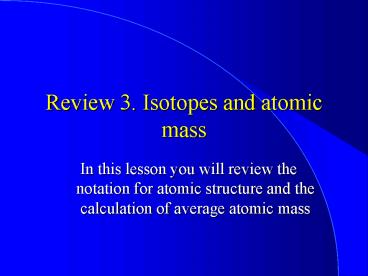Review 3' Isotopes and atomic mass - PowerPoint PPT Presentation
1 / 13
Title:
Review 3' Isotopes and atomic mass
Description:
... the notation for atomic structure and the calculation of average atomic mass ... Isotopes are two atoms with the same atomic number but different mass numbers ... – PowerPoint PPT presentation
Number of Views:263
Avg rating:3.0/5.0
Title: Review 3' Isotopes and atomic mass
1
Review 3. Isotopes and atomic mass
- In this lesson you will review the notation for
atomic structure and the calculation of average
atomic mass
2
Atomic structure
- A nucleus of protons and neutrons surrounded by a
cloud of electrons. - Protons (p) have a 1 charge and weigh about 1
atomic mass unit - Neutrons (n0) have no charge and weigh slightly
more than protons - Electrons (e) have a 1 charge and weigh about
0.00055 atomic mass unit
3
Atomic number, mass number, and charge
- Atomic number Z number of p
- Identifies the element found on periodic table
- Mass number A p n0
- Charge p e
- Atoms are neutral p e
- Atoms acquire a charge by losing or gaining e
- An atom with a charge is called an ION
4
Notation
charge p e
mass number p n0
A
?
E
Z
atomic number p
assume charge is zero if not shown
5
Give the structure (p, n0, e)of these atoms
19F
- 9 p, 10 n0, 9 e
- 11 p, 12 n0, 10 e
- 92 p, 143 n0, 92 e
- 16 p, 18 n0, 18 e
23Na1
235U
34S2
6
Give the symbol of each atom or ion
- 35 p, 44 n0, 36 e
- 79Br1
- 47 p, 62 n0, 46 e
- 109Ag1
- 26 p, 28 n0, 26 e
- 54Fe
7
Isotopes
- Isotopes are two atoms with the same atomic
number but different mass numbers - They are atoms of the same element but their
nuclei differ - same number of protons
- different numbers of neutrons
- Isotopes of Li 6Li (lithium-6) has 3 p, 3 n0
and 7Li (lithium-7) has 3 p, 4 n0
8
Average atomic mass
- An elements atomic mass is the weighted average
of the masses of the naturally occurring isotopes
of that element - atomic mass (abundance1 x mass1)
(abundance 2 x mass2) . . .
9
How to calculate the average atomic mass
- Magnesium occurs as three isotopes 24Mg, mass
23.98504 amu (78.99) 25Mg, mass 24.98584 amu
(10.00) 26Mg, mass 25.98259 amu (11.01) - The average atomic mass of Mg is (0.7899 x
23.98504) (0.1000 x 24.98584) (0.1101 x
25.98259) 24.31 amu - Be careful about sigfigs!
10
Atomic mass
- Two natural isotopes of antimony exist. 57.3
exists as 121Sb (mass 120.9038 amu), and the rest
is 123Sb (mass 122.9041 amu). What is the atomic
mass of antimony? - The abundances must total 100, so you can figure
out the abundance of 123Sb - (0.573 x 120.9038) (0.427 x 122.9041) 121.8
amu
11
Percent abundance
- Two natural isotopes of copper exist, 63Cu
(62.9296 amu) and 65Cu (64.9278 amu). What is
the abundance of each isotope? - The abundances must total 100
- If x 63Cu abundance, then 1-x 65Cu
- The average mass is found on the periodic table
- x 62.9296 (1-x) 64.9278) 63.546
- x 0.6915 and 1-x 0.3085
- 63Cu 69.15 and 65Cu 30.85
12
The bottom line
- You should be able to define atomic number and
mass number - You should be able to describe the structure of
any atom, given its complete symbol (or write the
symbol, given its structure) - You should be able to calculate average atomic
mass, isotope mass, and percent abundance from
the appropriate data
13
Where to get more information
- For more about atomic structure, see Chapter 2,
section 6 in your text - For more on isotope mass and atomic mass, see
Chapter 2, section 8 in your text































